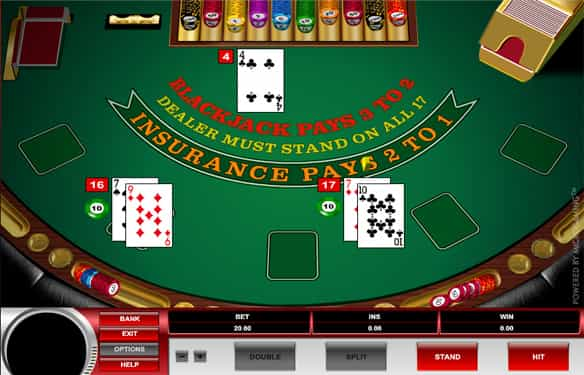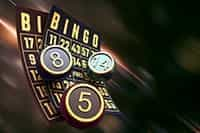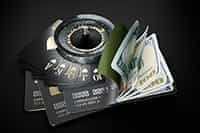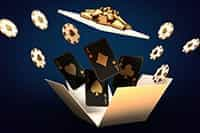The Best Online Blackjack Sites: Real Money Blackjack Casinos for 2025
With so many excellent blackjack operators out there, the options can be overwhelming. That’s why our expert reviewers have evaluated the online casino sites in the UK, focusing on game variety, RTP, bonuses, and more. Here’s a summary of our findings so that you can find the best online blackjack sites:
| Position | Blackjack Casino | Site Rating | Welcome Bonus | Blackjack Games | Best Blackjack Game | Live Tables | Secure Play Link | Casino Review | T&C |
|---|---|---|---|---|---|---|---|---|---|
| 1 | ⭐ Ladbrokes | 5.00/5 | £30 | 27 | Blackjack Surrender | 18 | Visit Site | Read Review | Full T&Cs Apply. 18+. New Casino players only. Deposit required. Bet £10+ on qualifying games. 40x wager reqs (bonus only) on selected games. Accept Bonus within 14 days. Bonus valid for 30 days. Certain deposit types excluded. Player restrictions and T&Cs apply. |
| 2 | ⭐ Duelz | 4.95/5 | Up to £100 + 100 Spins | 15 | Double Exposure | 33 | Visit Site | Read Review | Full T&Cs apply. 18+ new players only. Min deposit: £20. Max £100 bonus. Max bet with active bonus: £2. Wagering required 100% match bonus: 30x deposit + bonus. Max win from welcome bonus: £500. 100 Free Spins are given out 20 per day on Book of Dead for 5 days in a row. Max Free Spins winnings: £100. Free Spins winnings credited as bonus money with 45x wagering & 3 days expiry. Deposit bonus & Free Spins wins are forfeited 30 days after bonus is credited if the wagering is not met. Game weighting and restrictions apply. Play Responsibly www.gambleaware.org |
| 3 | ⭐ Mr Mega | 4.90/5 | Up to £80 Welcome Bonus | 1 | Blackjack | 12 | Visit Site | Read Review | Full T&Cs Apply. 18+, WELCOME BONUS: NEW PLAYERS ONLY, 1ST DEPOSIT, MIN DEPOSIT: £10, MAX £80. WAGERING REQUIREMENTS APPLY 35X. |
| 4 | ⭐ Coral | 4.80/5 | Bet £10, Get £50 | 20+ | Buster Blackjack | 32 | Visit Site | Read Review | Full T&Cs Apply. 18+. New Casino players only. Deposit req (certain types excluded). Bet £10+ on qualifying games to get a £50 Bonus (selected games, 40x wag req, accept within 14 days, valid for 30 days). |
| 5 | ⭐ Fitzdares | 4.75/5 | £100 | 16 | American Blackjack | 27 | Visit Site | Read Review | Full T&Cs apply. New customers only aged 18+. Minimum deposit £10. Get a Casino Bonus matched to your first deposit, up to £100, after you stake £20 on slots, credited within 48 hours. Bonus expires in 7 days and has a 40x wagering requirement. Additional T&Cs apply. Please bet responsibly. |
| 6 | ⭐ Monopoly Casino | 4.70/5 | £50 | 22 | Blackjack Pro | 5 | Visit Site | Read Review | #AD Full T&Cs Apply. New members only, must opt-in. Min £10 deposit & wager. 30-day expiry from deposit.18+. Free Spins: on MONOPOLY Paradise Mansion. 1p coin size, max lines. Bingo: Advertised ticket value based on £1 tickets. Game availability & restrictions apply. GambleAware.org |
| 7 | ⭐ Grand Ivy | 4.65/5 | 100% up to £300 + 25 Bonus Spins | 20 | American Blackjack | 37 | Visit Site | Read Review | Full T&Cs Apply. 18+. New players only. One bonus offer per player. Minimum deposit £20. Max bonus bet is £5. Bonus spins on selected games only and must be used within 72 hours. Bonus funds must be used within 30 days otherwise any unused bonus shall be removed. Bonus funds are 100% match up to £300 on your 1st deposit. Bonus funds are separate to Cash funds, and are subject to 35x wagering the total bonus & cash. Only bonus funds contribute towards any wagering requirements. Terms apply. GambleAware.org. |
| 8 | ⭐ Betway | 4.60/5 | £50 | 20 | Multi-Hand Blackjack | 10 | Visit Site | Read Review | Full T&Cs apply. New customers only. Opt-in required. 100% Match Bonus up to £50 on 1st deposit of £10+. 50x bonus wagering applies as do weighting requirements. Debit Card & PayPal deposits only. This offer is valid for 7 days from your new account being registered. Irregular gameplay may invalidate your bonus. |
| 9 | ⭐ ThePools | 4.60/5 | Up to 100 Spins | 10 | European Blackjack | 33 | Visit Site | Read Review | Full T&Cs apply. New Customers only. 18+, UK only. Deposit & stake £10 get 100 free spins on 'Big Catch Bass Fishing' slot. |
| 10 | ⭐ Grosvenor | 4.55/5 | Deposit £20, Play with £50 Welcome Bonus | 7 | Atlantic City Blackjack | 35 | Visit Site | Read Review | Full T&Cs Apply. New customers only. Min deposit £20 (exc paypal). Max bonus £30, bonus amount non-withdrawable, playable on selected games only. 30x wagering for £30 bonus. Expires within 30 days. Max win £2,000. |
Highlights of the Best Blackjack Casinos
Are you overwhelmed by the huge choice of online blackjack casinos? We’ve organised them for effortless exploration. Our goal is to assist you in finding the perfect site that aligns with your unique gaming preferences.
Whether you’re into low or high stakes, there’s a blackjack site that fits the bill. We spotlight platforms specialising in specific variants and those with standout payment options, guaranteeing a diverse and satisfying experience for every player.
Unsure where to start? Head straight to our top-recommended site, a prime choice for blackjack. Or stick around as we explore the details, guiding you through the world of online blackjack.
If you’re new to online casinos, it can all feel a bit much initially. Why not start with our list of the best online casinos? It’s full of useful info to get you going, covering everything you need to know.
- Card Counting Learn how to count cards in Blackjack
- Strategies/Systems Details of all blackjack systems and game strategies
- Games and Rules Learn how to play different variants
- History of the Game Details about how the game started
- HIGH STAKES The details about high roller blackjack
Is Online Blackjack Legal?
Online blackjack falls under the Gambling Act 2014, with the Gambling Commission ensuring fairness and safety for players. This follows the framework set by the 2005 Gambling Act [1] . You must be 18 or over to play online blackjack. The UK’s regulatory environment prioritises player safety, demanding that operators prevent underage play and promote responsible gaming. Additionally, blackjack games are independently tested for fairness [2] .

We believe the UK leads the way in gambling regulation, balancing player safety with a wide range of options. For peace of mind, make sure to play at sites licensed by the Gambling Commission.
How We Picked the Best Blackjack Casinos
When selecting an online blackjack casino, variety is key. Ensure the site has classic blackjack along with other variants. A live dealer section with professional croupiers increases your options for play.
Having a range of payment methods, a solid mobile app, and clear bonus deals for online blackjack players is just as important. Below, we outline how we evaluate evry site our experts examine:
The foundation of the best internet blackjack experience is its licensing and regulation. Playing at licensed sites ensures strict compliance with fairness and security standards, which is vital for game integrity and player safety.
From our perspective, it’s not worth the risk to venture outside regulated settings. Always select blackjack online casinos licensed by the Gambling Commission for the most trusted play.
Reliable and Fair Online Blackjack
You’re probably savvy about internet security, from protecting your passwords [3] to avoiding sketchy websites. When exploring the best online blackjack casinos, you’ll need to consider extra security factors. Remember, common sense is your most important tool in staying safe online.
To ensure a safe online casino session, check the site’s valid licence, confirm regulation, conduct RNG audits for fair play, and use SSL encryption [4] for data protection. These three factors are crucial for peace of mind while engaging in any online gambling activity.
- RapidSSL
- GoDaddy
- Comodo
- Thawte
- DigiCert
- Symantec
- eCOGRA
- TST
- GLI
- BMM
- iTechLabs
- SQS
- Quinel
- NMi
- Gambling Commission
Offshore licences [5] don’t automatically apply in the UK. To legally offer services, a blackjack online casino must hold a licence from the Gambling Commission, confirming it adheres to the country’s regulatory standards.
To check an SSL certificate’s issuer and validity, click the padlock next to the site’s URL in your browser. This will show a drop-down with the certificate’s details, assuring you of the site’s encryption and security.
RNG audits and payout reports are usually done yearly. RNG audits make sure games are fair and not manipulated, and payout reports show the percentage of bets paid back to players, highlighting the casino’s fairness and openness.
Online Blackjack Games – RNG Variations
In the UK, certain blackjack variations stand out. Classic Blackjack is always popular for its simple rules [6] . With its two decks and special split rule, European Blackjack offers something different. Meanwhile, American Blackjack uses six to eight decks, presenting a unique challenge. Atlantic City Blackjack, often played with eight decks, offers the option of late surrender, adding a strategic layer. Vegas Strip Blackjack uses four decks and has its own set of rules for splitting, distinguishing it from other variants.
Modern variations feature First Person Blackjack, providing a 3D experience that immerses players in the game. Multihand Blackjack allows handling several hands at once for a faster pace. Double Exposure initially shows both of the dealer’s cards, introducing a new strategic element.
Find below the most popular RNG blackjack games for our readers:
Among the blackjack variants, European Blackjack boasts the simplest rules, ideal for beginners. Vegas Strip Blackjack , with its interesting side bets, provides additional layers of strategy and excitement.
However, for players keen on maximising returns, Double Exposure Blackjack often stands out in the best-paying online casinos, offering superior odds compared to its counterparts.
Online Blackjack Live Dealer Tables
Live blackjack brings the realism of a real-life dealer to your screen, moving beyond RNG outcomes. With HD streaming, it combines online convenience with the dynamics of live play.
Set in studios that replicate a casino’s luxury, dealers shuffle and deal cards like in a physical location. Players bet at blackjack online casinos, and the game progresses based on their choices, with the dealer reacting in real time.
| Ladbrokes | £30 | Classic Live Suite, Novel Quiz Games, Bountiful Tables | Play Here! | Full T&Cs Apply. 18+. New Casino players only. Deposit required. Bet £10+ on qualifying games. 40x wager reqs (bonus only) on selected games. Accept Bonus within 14 days. Bonus valid for 30 days. Certain deposit types excluded. Player restrictions and T&Cs apply. |
At live dealer casinos, you can chat with the dealer and sometimes other players. This adds a social aspect to the best online blackjack casinos, allowing for questions, comments, or casual talk.
This format allows for real-time decision-making, adding an authentic touch that’s hard to replicate in standard online games. It bridges the gap between the traditional casino setting and the digital age, offering the best of both worlds. Live blackjack casinos have changed the game by combining online gaming ease with the real feel of a physical casino. This mix attracts players who like technology and those who prefer traditional play.
Best RTP Blackjack Games Online
RTP, or Return to Player, shows how much a game pays back to players over time. Online blackjack often has an RTP above 99%, meaning you could get back around £99 for every £100 bet.
Blackjack’s RTP stands out compared to roulette or slots. Roulette’s RTP ranges from 94.74% (American) to 97.3% (European). Slot games vary more, with RTPs between 90% and 98%, depending on the slot.
| Best RTP Blackjack Games | Top Payout Side Bets |
|---|---|
| 99.87% – Blackjack Switch | 95.14% – Super Match (6 Decks) |
| 99.65% – European Blackjack | 93.34% – Royal Match (6 Decks) |
| 99.60% – Vegas Strip Blackjack | 95.01% – Perfect Pair (8 Decks) |
| 99.60% – Atlantic City Blackjack | 97.22% – 21+3 (6 Decks) |
| 99.55% – Single Deck Blackjack | 96.24% – 21+3 (1 Deck) |
| 99.50% – Classic Blackjack | 93.34% – Royal Match (6 Decks) |
| 95.25% – Perfect Pairs | 97.45% – Super Match (1 Deck) |
| 95.15% – Progressive Blackjack | 97.33% – Match the Dealer (8 Decks) |
| 95.00% – 21+3 | 97.22% – 21+3 (6 Decks) |
| 95.00% – Cashback Blackjack | 95.05% – 6 in 1 (6 Decks) |
| 95.00% – Super 7 Multihand | 97.31% – Straight 8´s (6 Decks) |
Placing side bets when you play blackjack online add excitement and the chance for big wins at real money casino sites, but they usually have a lower RTP. This makes blackjack less advantageous compared to other casino games.
Sticking to the basic strategy in blackjack gives you the best odds. This approach involves making the best possible decision for your hand against the dealer’s visible card, offering the highest RTP. Avoiding side bets and insurance [7] can also help tilt the odds in your favour.
All Real Money Blackjack Games
- 3 Hands Blackjack
- 6 in 1 Blackjack
- 21 Duel Blackjack
- 21 + 3 Blackjack
- American Blackjack
- Atlantic City Blackjack
- Buster Blackjack
- Blackjack Peek
- Blackjack Pro
- Blackjack Surrender
- Blackjack Switch
- Blackjack UK
- Classic Blackjack Gold
- Classic Touch Blackjack
- Deal or No Deal
- Double Attack
- Double Exposure
- European Blackjack
- European Blackjack Gold
- European Redeal Gold
- Flip Card
- Hi Lo 13 European Gold
- Lucky Ladies Blackjack
- Lucky Lucky Blackjack
- Perfect Blackjack
- Perfect Pairs / 21 + 3
- Perfect Pairs Blackjack
- Perfect Pairs Multi Hand
- Pontoon
- Progressive Blackjack
- Players’ Choice
- Premium Blackjack
- Red Queen
- Red Tiger Blackjack
- Single Deck Professional
- Spanish 21
- Suit’em Up Blackjack
- Super 7’s Multi Hand
- Super 21 Blackjack
- Super Fun 21
- Vegas Downtown
- Vegas Single Deck
- Vegas Strip Blackjack
- Vegas Strip Gold
- Dr Fortuno Blackjack
- Blackjack Players Suite
- Neon Blackjack
- Pirate 21
- Single Deck Blackjack
- Super 7
- Blackjack French
- Blackjack Multihand
- Neon Single Deck Blackjack
- Trump It Blackjack
- Trump It Blackjack Single Deck
- Blackjack Fast
- Blackjack Neo
- Hi-Lo Blackjack
- Super Stakes Blackjack
- Zappit Blackjack
- American Blackjack Turbo
- European Blackjack Turbo
- Lucky Blackjack
- Sonya Blackjack
- Multi Hand 3D
- Multi Hand VIP
- Single Hand
- Blackjack VIP
- Pro Multi-Hand
- EU Classic MH
- Free Chip
- MH Classic Gold
- Vegas Strip Single
- Blackjack 3D
- Big Five Gold
- Double Exposure Multi Hand
- Premier High Streak
- Blackjack Reno
- Spanish Gold
Bonuses Available on Blackjack
It’s common to find a regulated blackjack casino [8] with a welcome bonus for new players. However, the wagering requirements for blackjack bonuses often don’t favour the player. Despite this, there are still some opportunities available, as shown below.
| Blackjack Casino | Blackjack Bonus | Important Terms | Rating | Secure Link | T&C |
|---|---|---|---|---|---|
| Ladbrokes | £30 | 30x, 10% | Claim Bonus! | Full T&Cs Apply. 18+. New Casino players only. Deposit required. Bet £10+ on qualifying games. 40x wager reqs (bonus only) on selected games. Accept Bonus within 14 days. Bonus valid for 30 days. Certain deposit types excluded. Player restrictions and T&Cs apply. | |
| Duelz | Up to £100 + 100 Bonus Spins | 30x, 10% | Claim Bonus! | Full T&Cs apply. 18+ new players only. Min deposit: £20. Max £100 bonus. Max bet with active bonus: £2. Wagering required 100% match bonus: 30x deposit + bonus. Max win from welcome bonus: £500. 100 Free Spins are given out 20 per day on Book of Dead for 5 days in a row. Max Free Spins winnings: £100. Free Spins winnings credited as bonus money with 45x wagering & 3 days expiry. Deposit bonus & Free Spins wins are forfeited 30 days after bonus is credited if the wagering is not met. Game weighting and restrictions apply. Play Responsibly www.gambleaware.org | |
| Mr Mega | £80 | 35x, 10% | Claim Bonus! | Full T&Cs Apply. 18+, WELCOME BONUS: NEW PLAYERS ONLY, 1ST DEPOSIT, MIN DEPOSIT: £10, MAX £80. WAGERING REQUIREMENTS APPLY 35X. |
Casino bonuses usually have wagering requirements, setting how much you need to bet to withdraw bonus winnings. If blackjack only counts for about 10% of these requirements, then only £1 of every £10 bet on blackjack goes towards meeting the criteria.
Blackjack’s low contribution to bonus wagering is due to its high RTP. With strategies, players can reach an RTP of over 99%, making it one of the most favourable games for players.
Casinos lower blackjack’s contribution to safeguard their interests, preventing players from easily exploiting bonuses in a game with such advantageous odds.
The Best Blackjack App
Mobile gaming has seen a huge increase in popularity, with blackjack leading the way. Smartphones and tablets allow players to enjoy their favourite blackjack games from any location.
In the debate between HTML5 and app-based platforms, both have their advantages. HTML5 blackjack games offer versatility, enabling play directly from a browser without extra downloads. This compatibility across various devices often makes it the preferred choice.
| Ladbrokes | £30 | Ultra Graphics, Push Promotions, Clean Display | Play Here! | Full T&Cs Apply. 18+. New Casino players only. Deposit required. Bet £10+ on qualifying games. 40x wager reqs (bonus only) on selected games. Accept Bonus within 14 days. Bonus valid for 30 days. Certain deposit types excluded. Player restrictions and T&Cs apply. |
Meanwhile, dedicated mobile casinos usually provide a smoother user experience thanks to tailored features and quicker load times. Many of the best mobile apps focus on blackjack, enhancing graphics, sound, and functionality for smaller screens.
Players might question whether mobile devices compromise the visual quality of blackjack. However, technological advancements have optimised game designs to appear sharp and clear on compact screens. From our perspective, when you blackjack games online, the enjoyment remains fully preserved on mobile platforms.
The UK’s Favourite Blackjack Software Developers
This game transcends borders. The games available globally match those in the leading online blackjack casinos. Whether from renowned casino software developers or smaller boutique firms, the range of both RNG and live blackjack options for players is vast.
- 1. Evolution Gaming: Primarily renowned for their live casino suite, Evolution has been a dominant force in the live blackjack segment, offering top-tier streaming quality and diverse table selections tailored for all kinds of players.
- 2. Playtech: Playtech, while known for a diverse portfolio, offers an array of RNG blackjack variants. Their games are appreciated for their crisp visuals, fluid mechanics and user-friendly interfaces, catering to both novices and seasoned players.
- 3. Microgaming: A titan in the online gaming world, Microgaming is celebrated for its RNG-based blackjack offerings. Their games, known for high-quality graphics and smooth gameplay mechanics, have set industry standards and remain favourites for those seeking a classic blackjack experience.
- 4. NetEnt: NetEnt’s strength in the digital realm shines through their RNG blackjack games. They deliver classic blackjack experiences combined with impeccable graphics and sound. Their titles often emphasise intuitive gameplay, making them a go-to for many blackjack enthusiasts.
Evolution, NetEnt, Playtech and Microgaming, as highlighted above, are top software developers offering blackjack games. These are extensively available at numerous blackjack online casinos, guaranteeing players enjoy top-notch gameplay.
Payment Methods at Blackjack Sites
The best blackjack casino sites all offer similar payment options, with debit cards and major eWallets being common. Innovative methods are available at certain venues. However, credit card payments for gambling are banned.
- Visa
- PayPal
- Neteller
- Trustly
- Paysafecard
- Payz
- Skrill
Seeking a casino with fast withdrawals? You’ll need some patience. While deposits are instant, withdrawing from a blackjack casino online can take from 24 hours to seven days, depending on the payment method used, typically the same one for deposits.
Land Based Blackjack Casinos
The UK is home to numerous land-based casinos. Notable venues include The Hippodrome in London, which offers classic blackjack and variations like Double Exposure, and Aspers in Stratford with standard blackjack and Blackjack Switch.
Genting International Casino at Resorts World Birmingham is another prime location. It not only presents traditional blackjack but also introduces players to exciting variations, ensuring that both novices and seasoned players find something to suit their taste.
Compared to these traditional establishments, the best online blackjack casinos often boast a broader game variety and greater convenience. They cater to diverse player preferences, each offering unique advantages and regulation.
| 🏛️ Land-Based Casinos | 135 |
|---|---|
| 💻 All Licensed Online Casinos | 200 |
| 🏆 Best-Rated Blackjack Casinos | 10 |
Which Blackjack System is the Most Popular?
The most favoured blackjack approach is basic strategy. It relies on statistical probabilities to advise the player on the best action (hit, stand, double down, split, or surrender) for every possible hand against the dealer’s visible card.
Applying basic strategy can lower the house advantage to under 1% in most blackjack variants. Beyond this strategy, card counting is a technique for experienced players, but it’s more intricate and demands considerable practice. Note that it is not possible to count cards in most RNG blackjack games, as the cards are shuffled after every round.
Many casinos discourage card counting and might ask counters to leave. It’s important to remember that while strategies can lower the house edge, no system ensures constant wins when playing a blackjack game online. Always gamble responsibly [9] .
Conclusion: Play Blackjack at Our Recommended Online Casinos
Online blackjack in the UK is not only legal and safe but is also held to high standards. We’ve meticulously reviewed numerous casinos to ensure that our recommendations are top-notch.
Among these, Ladbrokes stands out as the best online blackjack casino. This is due to its user-friendly interface, diverse blackjack variants, top-tier software quality, and impeccable customer service.
Our personal experience with Ladbrokes confirmed its stellar reputation, positioning it as our top choice for anyone looking for an outstanding online blackjack session.

UK players can explore numerous licensed and reputable sites. Our unbiased, data-driven reviews focus on trusted operators, guiding you to the best online casinos for blackjack.
Go through our best sites once more to find a trusted blackjack casino that takes your eye. See if the bonus offer is one that suits your purse or whether they have enough blackjack games to keep you entertained,
More Expert Gambling Guides for British Players
Check out more pages on our site about online gambling. Each page focuses on a topic and suggests top-rated online casinos with unique features. After all, there might be better online roulette or slot choices than specific online casinos for blackjack.
Frequently Asked Questions
The vast world of online blackjack gambling is inundated with information, often leaving British gamers sifting through endless sources in search of clear answers. Recognising this challenge, we’ve curated a comprehensive list addressing the most frequently posed queries from the gaming community.
Where can UK players locate top online blackjack sites?
For British enthusiasts seeking quality online blackjack, numerous options abound. We've carefully shortlisted premier blackjack casinos, with each providing an enticing welcome bonus tailored for UK players, ensuring a rewarding start for newcomers.
Is online blackjack legal for UK residents?
In the UK, playing blackjack online is entirely legal, but it's imperative to engage only with platforms licensed by the UKGC. For comprehensive insights into legitimate blackjack sites, peruse our dedicated section.
Which blackjack variants resonate with British players?
We've showcased several outstanding online blackjack games. Determining the singular best is subjective due to diverse preferences, but we've considered player feedback and game quality in our recommendations.
How does live blackjack operate for UK participants?
In the UK, live blackjack emulates the brick-and-mortar experience seamlessly. Via live streaming, players engage with genuine dealers, placing real-time bets. This immersive setup allows comfortable home-based participation.
What bonuses are UK blackjack players entitled to?
British players are spoiled with blackjack bonus choices. Almost every online casino extends a rich welcome offer. However, it's paramount to meticulously scan the terms to ensure that blackjack participation contributes to any promotional requirements.
References
Below you’ll find a list of the resources we have used in compiling this guide to playing online blackjack for real money. Also included is a webpage’s publication date, if available as well as the date we accessed the page for reference.
- Gambling Act 2005. Available from: https://www.legislation.gov.uk/ukpga/2005/19/contents (Accessed March 26, 2024).
- Sample iTech Labs Fairness Report (PDF). Available from: https://download.gamesrv1.com/general/website/certificate/rng_certificate_080108.pdf (Accessed March 26, 2024).
- Secure Your Passwords. Available from: https://www.nyu.edu/life/information-technology/safe-computing/protect-your-privacy/secure-your-passwords.html (Accessed March 26, 2024).
- Online SSL Checker Tool. Available from: https://www.ssllabs.com/ssltest/ (Accessed March 26, 2024).
- Malta Gaming Authority. Available from: https://www.mga.org.mt/ (Accessed March 26, 2024).
- How to win at blackjack. 7 April 2002. Available from: https://www.theguardian.com/observer/osm/story/0,,678184,00.html (Accessed March 26, 2024).
- Blackjack Insurance Explained. Available from: https://en.wikipedia.org/wiki/Blackjack#Insurance (Accessed March 26, 2024).
- Fair and Transparent Terms and Practices. 17 May 2021 Available from: https://www.gamblingcommission.gov.uk/licensees-and-businesses/guide/fair-and-transparent-terms-and-practices (Accessed March 26, 2024).
- NHS Help for Gambling Addiction. Available from: https://www.nhs.uk/live-well/addiction-support/gambling-addiction/ (Accessed March 26, 2024).














